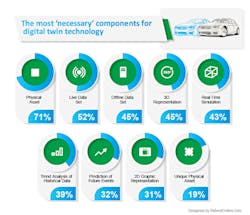Over the past few years, digital twins have been one of the major developments in product development and management. A digital twin is a computer model of a process or product with as much detail as the real thing in terms of relationships between components, materials, and design. A proper digital twin, one exposed to the inputs the real item experiences, lets companies see in real-time how a product or piece of machinery performs in the marketplace or factory and lets them do what-if analysis.
Digital twins are already used by manufacturing firms, including automakers and construction companies, to evaluate performance and identify where improvements can be made.
To get an idea of what engineers think about digital twins, the marketing firm Reboot Online analyzed the latest findings from a survey of 150 engineers from various disciplines and industries. They were asked what they believed is most necessary for digital twin technology to be effective.
The survey found that a “physical asset” (71%) is the component engineers think is the most necessary for digital twins. The second-most important necessity (52%) is a live data set. And third on the list (45%) is an “offline data set.”
Interestingly, with a digital twin being a pairing of the virtual and physical worlds, just 45% of engineers rate “3D representation” as a must-have variable for the technology. On a similar note, 31% say “2D graphic representation” is needed for digital twins to work properly.
Only 39% place “trend analysis of historical data” as a vital attribute. Even fewer believe “prediction of future events” (32%) is a critical aspect that can push the technology to achieve desired objectives.
Reboot Online also wanted to identify the stages in the product life cycle that gain the greatest value from digital twins. Survey respondents chose “maintenance, repair, and operations” (77%) as the stage in a product’s life cycle where digital twins add the greatest value. After that, “manufacturing” (70%) comes in second, with “simulation of a model that predicts the current and future behavior” (62) in third. In fourth place, (60%) almost two thirds say digital twins can be highly practical for “quality control” testing. And close behind in fifth, (59%) say they are most helpful in the “design” phase.
In contrast, “finance and procurement” (13%) is the step in the product life cycle engineers think will benefit from using digital twins. And just slightly more respondents (19%) point to “sales and marketing” as key operations which can be improved by using them.


